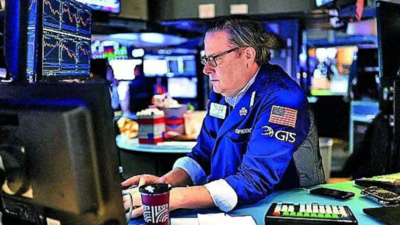US stock markets opened on a strong note Tuesday, with all three major indices posting solid gains as investor sentiment turned positive across sectors. The Dow Jones Industrial Average (DJIA), the NASDAQ, and the S&P 500 each rose over 1% in early trading, while commodity prices also edged higher.
During the initial minute of trading, The Dow Jones Industrial Average jumped 403.52 points, or 1.06%, to 38,573.93, driven by gains in financials and industrials. The Nasdaq Composite rose 198.15 points, or 1.25%, to 16,069.05, bolstered by strong performances from leading tech stocks. Meanwhile, the S&P 500 climbed 54.92 points, or 1.06%, to 5,213.12, as investors looked past recent concerns over interest rates and earnings volatility.
In the commodities market, gold continued its upward trend, rising $28, or 0.82%, to $3,453.30 per ounce, reflecting ongoing demand for safe-haven assets. Crude oil prices also advanced, with US benchmark oil gaining $0.67, or 1.06%, to $63.75 per barrel, amid growing geopolitical tensions and tightening supply outlooks.
Bond markets saw modest movement, with the yield on the US 10-year Treasury note falling 2.6 basis points to 4.379%, suggesting continued demand for government debt as investors maintain a cautious stance.
On the currency front, the euro weakened against the US dollar, with the EUR/USD pair slipping 0.005 points, or 0.417%, to 1.147, reflecting a slight strengthening of the greenback.
The CBOE Volatility Index (VIX), Wall Street’s fear gauge, dropped 2.16 points, or 6.39%, to 31.66, indicating easing investor anxiety as markets stabilize after weeks of fluctuation.
Earlier, Futures for the S&P 500 rose 0.8% before the bell, still far from recovering the 2.4% loss from Monday. Futures for the Dow Jones Industrial Average also rose 0.8%, and Nasdaq futures gained 0.9%. Both had slumped more than 2% the day before as Trump stepped up his public criticism of Powell.
Trump had been demanding that the central bank lower its key interest rate to boost the economy. Trump had called Powell “a major loser” and said that energy and grocery prices were “substantially lower,” claiming that the central bank no longer needed to keep interest rates elevated to suppress inflation.
The Fed had resisted lowering rates quickly, fearing that it could reignite inflation after it had soared to more than 9% during the height of the COVID-19 pandemic three years ago.
Any attempt to unseat Powell would have set off a crisis in global financial markets. While Wall Street favored lower rates because they generally boosted stock prices, the bigger concern was that a less independent Fed could struggle to keep inflation under control. Such a move could weaken, if not destroy, the United States’ reputation as the world’s safest place to keep cash.
Longer-term yields had been rising recently due to doubts about the United States’ standing in the global economy. The yield on the 10-year Treasury had climbed to 4.43% overnight before settling at 4.39% in the morning. That was still up from 4.34% at the end of last week and about 4% earlier that month, a substantial move for the bond market.
The US dollar edged down to 140.24 Japanese yen from 140.80 yen. The dollar had been weakening against the yen and other currencies, briefly dipping as low as 139 yen on Monday, a 52-week low.
In equities trading early Tuesday, First Solar surged 7.2% after the Department of Commerce finalized harsher-than-expected solar tariffs on some Southeast Asian communities.
Northrop Grumman tumbled 10.6% after it reported that its first-quarter sales had fallen from a year ago. The military contractor also saw its profit nearly halved due to a big loss related to higher manufacturing costs for its B-21 bomber program.
Technology companies, which had taken some of the biggest hits during the recent market volatility, inched up in premarket Tuesday. Nvidia and Meta Platforms rose less than 1% before the bell.
Meta shares had declined for seven consecutive days, the longest losing streak for the company since April 2023.
One day after plummeting another 6%, Tesla shares inched up less than 1% in premarket trading ahead of its quarterly earnings report later that day.
Elon Musk’s electric car company had already reported that its first-quarter car sales dropped by 13% from the same time last year. This decline had occurred against a backdrop of vandalism, widespread protests, and calls for a consumer boycott amid a backlash to Musk’s high-profile role in overseeing a cost-cutting purge of US government agencies.
Tesla shares were down about 40% since the beginning of 2025.
In Europe at midday, France’s CAC 40 and Germany’s DAX each declined 0.7%, while Britain’s FTSE 100 was mostly unchanged.
Trading was cautious in Asia, where the benchmark Nikkei 225 lost 0.2% to finish at 34,220.60. Australia’s S&P/ASX 200 was virtually unchanged, inching down less than 0.1% to 7,816.70. South Korea’s Kospi lost nearly 0.1% to 2,486.64. Hong Kong’s Hang Seng added nearly 0.8% to 21,562.32, while the Shanghai Composite added 0.3% to 3,299.76.
Trump’s tariffs and China’s retaliatory measures hung as a shadow over the region.
“Across Asia, there was undoubtedly a sense of urgency to get to the negotiation table even as striking a deal at an appropriate cost had been tough,” said Tan Boon Heng from Mizuho Bank’s Asia & Oceania Treasury Department.
“China’s warning to countries not to resolve US tariffs by striking deals at the expense of Beijing’s interests revealed the geo-economic polarization.”
In energy trading, benchmark US crude gained 93 cents to $63.34 a barrel. Brent crude, the international standard, rose 88 cents to $67.14 a barrel.










More Stories
Boeing announces $10.55 billion sale of digital aviation assets to Thoma Bravo
Donald Trump tariffs to hit global economy hard! IMF cuts India’s GDP growth forecast to 6.2% for 2025; says it’s relatively more stable
US forecast to be hit hardest of major economies